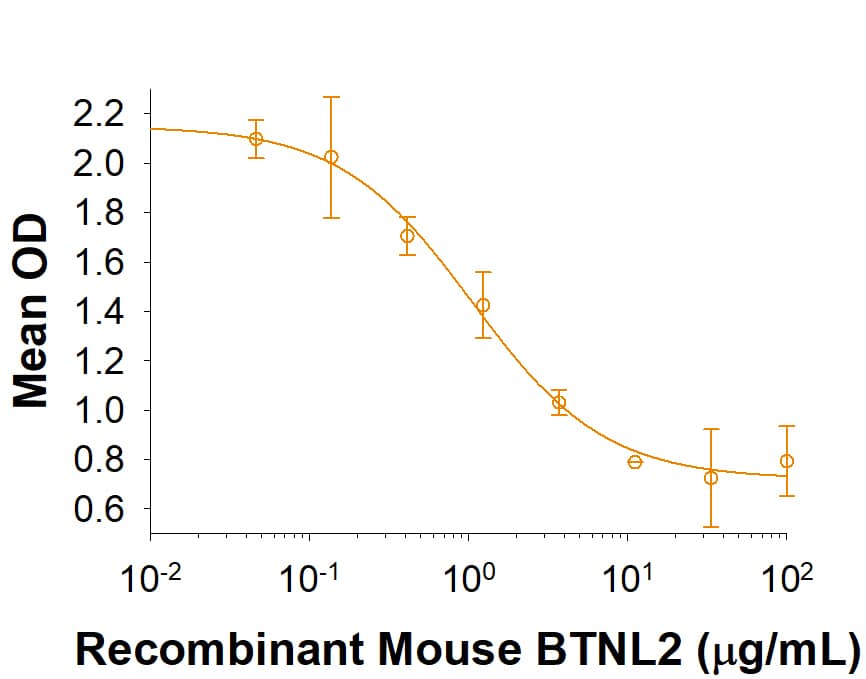Recombinant Mouse BTNL2/Butyrophilin-like 2 Protein, CF
R&D Systems, part of Bio-Techne | Catalog # 8605-BT

Key Product Details
Product Specifications
Source
Asp27-Ser452, with a C-terminal 6-His tag
Purity
Endotoxin Level
N-terminal Sequence Analysis
Predicted Molecular Mass
SDS-PAGE
Activity
The ED50 for this effect is 1-6 μg/mL.
Scientific Data Images for Recombinant Mouse BTNL2/Butyrophilin-like 2 Protein, CF
Recombinant Mouse BTNL2/Butyrophilin-like 2 Protein Bioactivity
Recombinant Mouse BTNL2/Butyrophilin-like 2 inhibits IL-2 secretion by mouse T cells in the presence of anti-CD3 antibody. The ED50 for this effect is 1-6 ug/mL.Formulation, Preparation and Storage
8605-BT
| Formulation | Lyophilized from a 0.2 μm filtered solution in PBS. |
| Reconstitution |
Reconstitute at 200 μg/mL in PBS.
|
| Shipping | The product is shipped at ambient temperature. Upon receipt, store it immediately at the temperature recommended below. |
| Stability & Storage | Use a manual defrost freezer and avoid repeated freeze-thaw cycles.
|
Background: BTNL2/Butyrophilin-like 2
Butyrophilin-like 2 (BTNL2) is a member of the BTN/MOG Ig-superfamily and functions as a negative regulator of immune cell activation (1).Mouse BTNL2 is a 514 amino acid (aa) type I transmembrane glycoprotein that contains a signal peptide followed by an extracellular domain (ECD), a transmembrane region and a short cytoplasmic domain (2). The ECD features two V-type Ig-like domains, two C-type Ig-like domains, and four glycosylation sites. The ECD of mouse BTNL2 (aa 27-452) shares 64% and 88% sequence identity with the ECD of human and rat BTNL2, respectively. A splice variant of BTNL2 lacks the second Ig-like domain in the ECD (2). BTNL2 is expressed in epithelial cells of the small intestine, colonic dendritic cells, and in cells of the lymph node (1, 2). BTNL2 expression is upregulated in T cells following activation, a characteristic BTNL2 shares with the homologous B7 family of co-stimulatory molecules (3, 4). BTNL2 negatively regulates T cells by inhibiting proliferation and inflammatory cytokine secretion (1, 3). It also increases the expression of FoxP3 in T cells to promote regulatory T cell development (5). Single nucleotide polymorphisms in BTNL2 are associated with a risk for sporadic prostate cancer, rheumatoid arthritis, sarcoidosis, ulcerative colitis, and other inflammatory diseases (2, 6-12).
References
- Arnett, H.A. et al. (2007) J. Immunol. 178:1523.
- Arnett, H.A. et al. (2009) Cytokine 46:370.
- Smith, I.A. et al. (2010) J. Immunol. 184:3514.
- Nguyen, T. et al. (2006) J. Immunol. 176:7354.
- Swanson, R.M. et al. (2013) J. Immunol. 190:2027.
- Morais, A. et al. (2012) Respir. Med. 106:1771.
- Milman, N. et al. (2011) Clin. Respir. J. 5:105.
- Wijnen, P.A. et al. (2011) Hum. Immunol. 72:342.
- Valentonyte, R. et al. (2005) Nat. Genet. 37:357.
- Pathan, S. et al. (2009) Tissue. Antigens 74:322.
- Mitsunaga, S. et al. (2013) J. Hum. Genet. 58:210.
- Fitzgerald, L.M. et al. (2013) Cancer Epidemiol. Biomarkers Prev. 22:1520.
Alternate Names
Gene Symbol
UniProt
Additional BTNL2/Butyrophilin-like 2 Products
Product Documents for Recombinant Mouse BTNL2/Butyrophilin-like 2 Protein, CF
Product Specific Notices for Recombinant Mouse BTNL2/Butyrophilin-like 2 Protein, CF
For research use only
